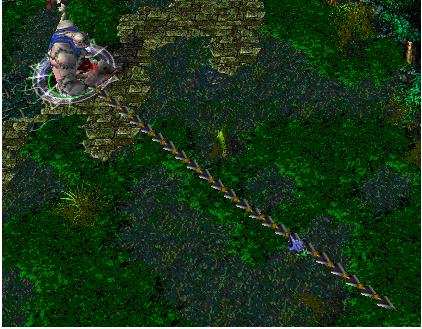Just a Hook
Time Limit: 4000/2000 MS (Java/Others) Memory Limit: 32768/32768 K (Java/Others)Total Submission(s): 9943 Accepted Submission(s): 4884
Problem Description
In the game of DotA, Pudge’s meat hook is actually the most horrible thing for most of the heroes. The hook is made up of several consecutive metallic sticks which are of the same length.

Now Pudge wants to do some operations on the hook.
Let us number the consecutive metallic sticks of the hook from 1 to N. For each operation, Pudge can change the consecutive metallic sticks, numbered from X to Y, into cupreous sticks, silver sticks or golden sticks.
The total value of the hook is calculated as the sum of values of N metallic sticks. More precisely, the value for each kind of stick is calculated as follows:
For each cupreous stick, the value is 1.
For each silver stick, the value is 2.
For each golden stick, the value is 3.
Pudge wants to know the total value of the hook after performing the operations.
You may consider the original hook is made up of cupreous sticks.

Now Pudge wants to do some operations on the hook.
Let us number the consecutive metallic sticks of the hook from 1 to N. For each operation, Pudge can change the consecutive metallic sticks, numbered from X to Y, into cupreous sticks, silver sticks or golden sticks.
The total value of the hook is calculated as the sum of values of N metallic sticks. More precisely, the value for each kind of stick is calculated as follows:
For each cupreous stick, the value is 1.
For each silver stick, the value is 2.
For each golden stick, the value is 3.
Pudge wants to know the total value of the hook after performing the operations.
You may consider the original hook is made up of cupreous sticks.
Input
The input consists of several test cases. The first line of the input is the number of the cases. There are no more than 10 cases.
For each case, the first line contains an integer N, 1<=N<=100,000, which is the number of the sticks of Pudge’s meat hook and the second line contains an integer Q, 0<=Q<=100,000, which is the number of the operations.
Next Q lines, each line contains three integers X, Y, 1<=X<=Y<=N, Z, 1<=Z<=3, which defines an operation: change the sticks numbered from X to Y into the metal kind Z, where Z=1 represents the cupreous kind, Z=2 represents the silver kind and Z=3 represents the golden kind.
For each case, the first line contains an integer N, 1<=N<=100,000, which is the number of the sticks of Pudge’s meat hook and the second line contains an integer Q, 0<=Q<=100,000, which is the number of the operations.
Next Q lines, each line contains three integers X, Y, 1<=X<=Y<=N, Z, 1<=Z<=3, which defines an operation: change the sticks numbered from X to Y into the metal kind Z, where Z=1 represents the cupreous kind, Z=2 represents the silver kind and Z=3 represents the golden kind.
Output
For each case, print a number in a line representing the total value of the hook after the operations. Use the format in the example.
Sample Input
1 10 2 1 5 2 5 9 3
Sample Output
Case 1: The total value of the hook is 24.
Source
Recommend
wangye
线段树 区间更新 区间求和
#include<stdio.h>
#define MAXN 200001
#define lson l,m,rt<<1
#define rson m+1,r,rt<<1|1
int num[MAXN<<2];
int top[MAXN<<2];
void PushUP(int rt)
{
num[rt]=num[rt<<1]+num[rt<<1|1];
}
void PushDown(int rt,int m)
{
if(top[rt])
{
top[rt<<1]=top[rt<<1|1]=top[rt];
num[rt<<1]=top[rt]*(m-(m>>1));
num[rt<<1|1]=top[rt]*(m>>1);
top[rt]=0;
}
}
void build(int l,int r,int rt)
{
top[rt]=0;
if(l==r)
{
num[rt]=1;
return ;
}
int m=(l+r)>>1;
build(lson);
build(rson);
PushUP(rt);
}
void update(int L,int R,int tmp,int l,int r,int rt)
{
if(L<=l && r<=R)
{
top[rt]=tmp;
num[rt]=tmp*(r-l+1);
return ;
}
PushDown(rt,r-l+1);
int m=(l+r)>>1;
if(m>=L)
update(L,R,tmp,lson);
if(m<R)
update(L,R,tmp,rson);
PushUP(rt);
}
int main(void)
{
int T,t;
// freopen("d:\\in.txt","r",stdin);
scanf("%d",&T);
for(t=1;t<=T;t++)
{
int n,q,X,Y,Z;
scanf("%d%d",&n,&q);
build(1,n,1);
while(q--)
{
scanf("%d%d%d",&X,&Y,&Z);
update(X,Y,Z,1,n,1);
}
printf("Case %d: The total value of the hook is %d.\n",t,num[1]);
}
return 0;
}
按照自己对线段树的理解重新写的代码,没必要一直求和,最后求就好了,开一个数组就好了,num[rt]表示区间内的值是多少,为0的时候代表区间里的值不统一.。
#include<cstdio>
#define maxn 110000
#define lson l,m,rt<<1
#define rson m+1,r,rt<<1|1
int num[maxn<<2];
void PushDown(int rt)
{
num[rt<<1]=num[rt<<1|1]=num[rt];
num[rt]=0;
}
void build(int l,int r,int rt)
{
num[rt]=0;
if(l==r)
{
num[rt]=1;
return ;
}
int m=(l+r)>>1;
build(lson);
build(rson);
}
void updata(int l,int r,int rt,int L,int R,int x)
{
if(l>=L && r<=R)
{
num[rt]=x;
return ;
}
if(num[rt])
PushDown(rt);
int m=(l+r)>>1;
if(L<=m)
updata(lson,L,R,x);
if(R>m)
updata(rson,L,R,x);
}
int Sum(int l,int r,int rt)
{
if(num[rt])
return (r-l+1)*num[rt];
int m=(l+r)>>1;
return Sum(lson)+Sum(rson);
}
int main()
{
int T,N,Q;
int x,y,z,t=1;
scanf("%d",&T);
while(T--)
{
scanf("%d%d",&N,&Q);
build(1,N,1);
while(Q--)
{
scanf("%d%d%d",&x,&y,&z);
updata(1,N,1,x,y,z);
}
printf("Case %d: The total value of the hook is %d.\n",t++,Sum(1,N,1));
}
return 0;
}





 本文介绍了一种解决游戏DotA中Pudge's Hook问题的算法实现,通过线段树结构进行区间更新与求和操作,高效计算钩子在经过一系列材质变化后的总价值。
本文介绍了一种解决游戏DotA中Pudge's Hook问题的算法实现,通过线段树结构进行区间更新与求和操作,高效计算钩子在经过一系列材质变化后的总价值。
















 394
394

 被折叠的 条评论
为什么被折叠?
被折叠的 条评论
为什么被折叠?








